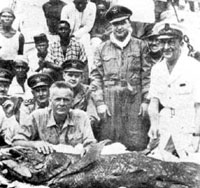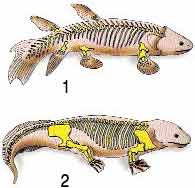 |
THE END OF THE MYTH The coelacanth lives! The team that caught the first living coelacanth in the Indian Ocean on 22 December, 1938, is seen here with the fish. |
The absence of intermediate form fossils between fish and amphibians is a fact evolutionists also admit to today. However, until 70 years ago, it was accepted that a fossil fish called the coelacanth was an outright intermediate form. Evolutionists claimed that the coelacanth, which was estimated to be 410 million years of age, was a transitional form with a primitive lung, a developed brain, a digestive and a circulatory system ready to function on land, and even a primitive walking mechanism. These evolutionary interpretations were accepted as undisputed truth in scientific circles until the end of the 1930's.
However, on December 22, 1938, a very interesting discovery was made in the Indian Ocean. A living member of the coelacanth family, previously presented as a transitional form that had become extinct 70 million years ago, was caught! The discovery of a "living" prototype of coelacanth undoubtedly gave evolutionists a severe shock. The evolutionist paleontologist, J.L.B. Smith, said that he could not have been more surprised if he had come across a living dinosaur.28 In the following years, more than 200 coelacanths were caught in different parts of the world.
Living coelacanths revealed how far evolutionists could go in making up their imaginary scenarios. Contrary to their claims, coelacanths had neither a primitive lung nor a large brain. The organ that evolutionist researchers claimed to be a primitive lung turned out to be nothing but a lipid pouch.29
Furthermore, the coelacanth, which was introduced as "a reptile candidate getting prepared to pass from sea to land", was in reality a fish that lived in the depths of the oceans and always stayed more than 180 metres below the surface.30
 |
IMAGINARY DRAWINGS AND A REAL COELACANTH Until a living specimen of it was found, evolutionists presented the coelacanth as the ancestor of "all land animals". Drawings such as the above were presented as fact and took their place in textbooks. When a living example of the fish was caught (side picture), all these evolutionist allegations were debunked. |
 | ||
1 Before a living example of it was caught, evolutionists believed that the coelacanth had organs which were half-fin and half-foot that enabled it to creep on land. When the living coelacanth was examined, it was understood that the fins of the fish had no such additional function. | 2 Evolutionists had claimed that the fish had a primitive lung. However, the organ that was supposed to be a primitive lung turned out to be a lipid pouch. | 3 It was asserted that the brain structure of the coelacanth also resembled that of land animals. However, it was revealed that its brain was no different from that of modern fish. |
 | THE DIFFERENCE BETWEEN FINS AND FEET The reason why evolutionists imagine the coelacanth and similar fish to be "ancestors of land animals" is that these fish have bony fins. They suppose that these bones turned into legs over time. However, there is a basic difference between the bones of these fish and the legs of land-dwelling animals: The bones of fish are not attached to the spinal column of the animal, as we see in the picture above. In land-dwelling animals, however, bones are directly fastened to the vertebral column, as we see in the picture below. Therefore, the claim that these fins gradually turned into legs is completely groundless. 1. Bones are unattached to the vertebral column |
28) Jean-Jacques Hublin, The Hamlyn Encyclopdia of Prehistoric Animals, New York: The Hamlyn Publishing Group Ltd., 1984, S. 120
29) Jacques Millot, "The Coelacanth", Scientific American, Band 193, Dezember 1955, S. 39
30) Bilim ve Teknik, November 1998, Band 372, S. 21